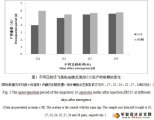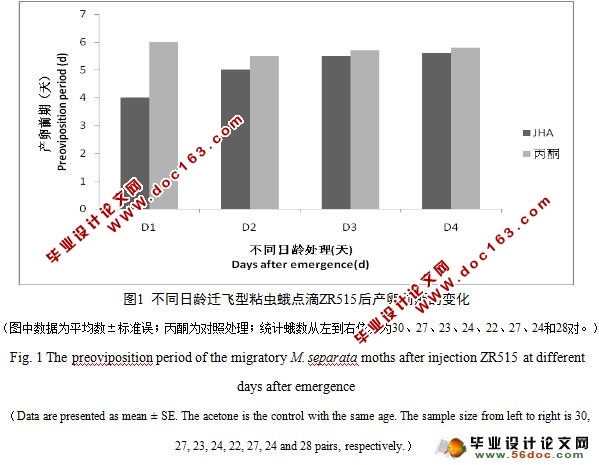Manse-AT对粘虫成虫生殖的影响

资料介绍:
Manse-AT对粘虫成虫生殖的影响(毕业论文12900字)
[资料来源:Doc163.com]
摘 要:迁飞是昆虫适应环境变化,维持种群繁衍的主要行为对策,也是迁飞害虫经常暴发成灾的主要原因。迁飞种群中通常存在着迁飞到他处生殖的迁飞型以及留在本地生殖的居留型,比例因其所处的环境不同而异。本文在前人已有的工作基础上,应用生理和生态的方法,对粘虫蛾迁飞型转化关键时期开展了进一步的研究,首次发现迁飞型粘虫成虫期存在保幼激素和促咽侧体素作用关键时期:保幼激素类似物点滴或促咽侧体素注射1日龄成虫,导致粘虫产卵前期显著缩短,产卵量及交配率显著上升等,其他日龄点滴则无类似影响。实验明确了保幼激素和促咽侧体素是粘虫关键时期的主要生理因子,揭示了迁飞型向居留型转化关键时期的调控机制是关键时期环境因子处理引起保幼激素和促咽侧体素在此时期水平的增加,从而导致迁飞型向居留型的转变。
关键词:粘虫;迁飞型;居留型;关键时期;保幼激素;促咽侧体神经肽
The Influence of Manse-AT on Reproduction of Armyworm
Abstract:Migration is the major behavioral strategy for a migratory insect species to adapt the variation of environment, the major causes for the largest number of individual and species in the animal kingdom, and for the frequent outbreaks of migrant pest inagro-ecosystem. A migrant population usually consists of migrant and resident,depending on the environmental conditions that the population underwent. Base on the researches, we carried out further studies on the sensitive period by using ecological and physiological methods in this paper,for clarifing the mechanism for migrants shifting into residents. The sensitive stage for JH and AT influencing migrant oriental armyworm was determined on day 1 after emergence. And the enhancement of JH and AT level in the seneitive stage is the mechanism for migrant shifting into resident.
Key words:Mythimna separata;migrant;resident;sensitive period;JH;AT

目 录
摘要…………………………………………………………………………………………1
关键词………………………………………………………………………………………1
1前言………………………………………………………………………………………2
1.1 我国粘虫发生及研究概况………………………………………………………2
1.2 关键时期的概念…………………………………………………………………3
1.2.1 粘虫关键时期的确定……………………………………………………3
1.2.2 关键时期起作用的主要环境因子………………………………………3
1.2.3 关键时期的生理特征与调控机制………………………………………4
2 材料与方法……………………………………………………………………………7
2.1 实验虫源及饲养方法…………………………………………………………7
2.2 JH和AT处理方法……………………………………………………………7
2.2.1 JH处理方法……………………………………………………………7
2.2.2 AT处理方法……………………………………………………………8
2.3 有关参数的确定………………………………………………………………8
3 结果与分析………………………………………………………………………8
3.1 JH处理关键时期的确定…………………………………………………………8
3.2 AT处理关键时期的确定………………………………………………………10
4 结论与讨论……………………………………………………………………………13
参考文献……………………………………………………………………………………14
致谢…………………………………………………………………………………………16
